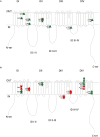Physiological and Pathophysiological Insights of Nav1.4 and Nav1.5 Comparison
- PMID: 26834636
- PMCID: PMC4712308
- DOI: 10.3389/fphar.2015.00314
Physiological and Pathophysiological Insights of Nav1.4 and Nav1.5 Comparison
Abstract
Mutations in Nav1.4 and Nav1.5 α-subunits have been associated with muscular and cardiac channelopathies, respectively. Despite intense research on the structure and function of these channels, a lot of information is still missing to delineate the various physiological and pathophysiological processes underlying their activity at the molecular level. Nav1.4 and Nav1.5 sequences are similar, suggesting structural and functional homologies between the two orthologous channels. This also suggests that any characteristics described for one channel subunit may shed light on the properties of the counterpart channel subunit. In this review article, after a brief clinical description of the muscular and cardiac channelopathies related to Nav1.4 and Nav1.5 mutations, respectively, we compare the knowledge accumulated in different aspects of the expression and function of Nav1.4 and Nav1.5 α-subunits: the regulation of the two encoding genes (SCN4A and SCN5A), the associated/regulatory proteins and at last, the functional effect of the same missense mutations detected in Nav1.4 and Nav1.5. First, it appears that more is known on Nav1.5 expression and accessory proteins. Because of the high homologies of Nav1.5 binding sites and equivalent Nav1.4 sites, Nav1.5-related results may guide future investigations on Nav1.4. Second, the analysis of the same missense mutations in Nav1.4 and Nav1.5 revealed intriguing similarities regarding their effects on membrane excitability and alteration in channel biophysics. We believe that such comparison may bring new cues to the physiopathology of cardiac and muscular diseases.
Keywords: Nav1.4; Nav1.5; associated/regulatory proteins; missense mutations; physiopathology.
Figures


Similar articles
-
Cardiac sodium channel Nav1.5 and its associated proteins.Arch Mal Coeur Vaiss. 2007 Sep;100(9):787-93. Arch Mal Coeur Vaiss. 2007. PMID: 18033008 Review.
-
SCN5A variant that blocks fibroblast growth factor homologous factor regulation causes human arrhythmia.Proc Natl Acad Sci U S A. 2015 Oct 6;112(40):12528-33. doi: 10.1073/pnas.1516430112. Epub 2015 Sep 21. Proc Natl Acad Sci U S A. 2015. PMID: 26392562 Free PMC article.
-
SCN4A variants and Brugada syndrome: phenotypic and genotypic overlap between cardiac and skeletal muscle sodium channelopathies.Eur J Hum Genet. 2016 Mar;24(3):400-7. doi: 10.1038/ejhg.2015.125. Epub 2015 Jun 3. Eur J Hum Genet. 2016. PMID: 26036855 Free PMC article.
-
Regulation of Cardiac Voltage-Gated Sodium Channel by Kinases: Roles of Protein Kinases A and C.Handb Exp Pharmacol. 2018;246:161-184. doi: 10.1007/164_2017_53. Handb Exp Pharmacol. 2018. PMID: 29032483 Review.
-
Mutations in NaV1.5 Reveal Calcium-Calmodulin Regulation of Sodium Channel.Front Physiol. 2019 Jun 5;10:700. doi: 10.3389/fphys.2019.00700. eCollection 2019. Front Physiol. 2019. PMID: 31231243 Free PMC article.
Cited by
-
Biophysical mechanisms of myocardium sodium channelopathies.Pflugers Arch. 2024 May;476(5):735-753. doi: 10.1007/s00424-024-02930-3. Epub 2024 Mar 1. Pflugers Arch. 2024. PMID: 38424322 Review.
-
Spliced isoforms of the cardiac Nav1.5 channel modify channel activation by distinct structural mechanisms.J Gen Physiol. 2022 May 2;154(5):e202112906. doi: 10.1085/jgp.202112906. Epub 2022 Mar 17. J Gen Physiol. 2022. PMID: 35297947 Free PMC article.
-
Ca2+-dependent regulation of sodium channels NaV1.4 and NaV1.5 is controlled by the post-IQ motif.Nat Commun. 2019 Apr 3;10(1):1514. doi: 10.1038/s41467-019-09570-7. Nat Commun. 2019. PMID: 30944319 Free PMC article.
-
Brugada Syndrome: Warning of a Systemic Condition?Front Cardiovasc Med. 2021 Oct 15;8:771349. doi: 10.3389/fcvm.2021.771349. eCollection 2021. Front Cardiovasc Med. 2021. PMID: 34722688 Free PMC article. Review.
-
New Challenges Resulting From the Loss of Function of Nav1.4 in Neuromuscular Diseases.Front Pharmacol. 2021 Oct 4;12:751095. doi: 10.3389/fphar.2021.751095. eCollection 2021. Front Pharmacol. 2021. PMID: 34671263 Free PMC article. Review.
References
-
- Ackerman M. J., Priori S. G., Willems S., Berul C., Brugada R., Calkins H., et al. . (2011). HRS/EHRA expert consensus statement on the state of genetic testing for the channelopathies and cardiomyopathies this document was developed as a partnership between the Heart Rhythm Society (HRS) and the European Heart Rhythm Association (EHRA). Heart Rhythm 8, 1308–1339. 10.1016/j.hrthm.2011.05.020 - DOI - PubMed
-
- Aiba T., Farinelli F., Kostecki G., Hesketh G. G., Edwards D., Biswas S., et al. . (2014). A mutation causing Brugada syndrome identifies a mechanism for altered autonomic and oxidant regulation of cardiac sodium currents. Circ. Cardiovasc. Genet. 7, 249–256. 10.1161/CIRCGENETICS.113.000480 - DOI - PMC - PubMed
Publication types
LinkOut - more resources
Full Text Sources
Other Literature Sources
Miscellaneous

